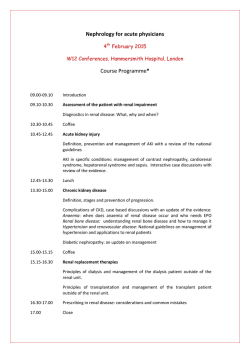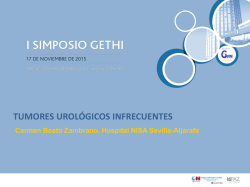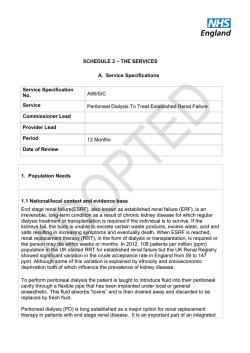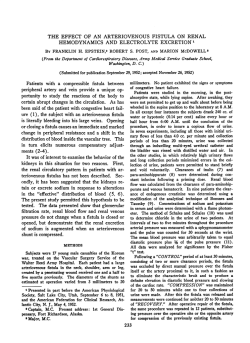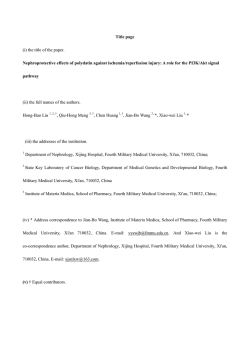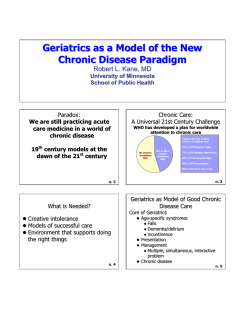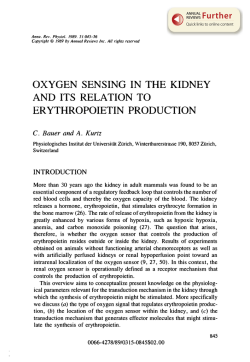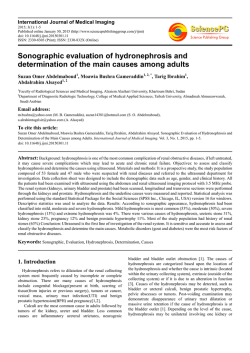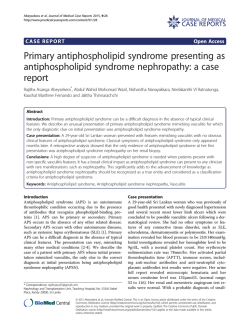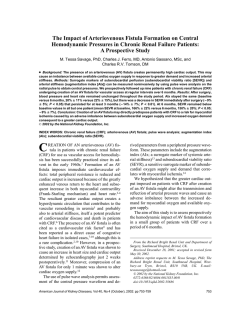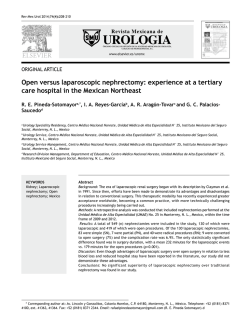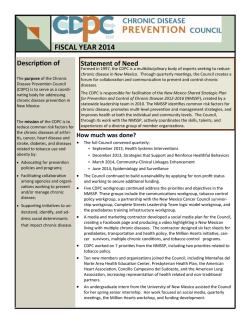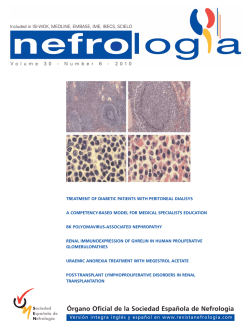
Diuretic Response and Cardiorenal Interaction in
Diuretic Response and Cardiorenal Interaction in Heart failure Mattia Adriano Egidio Valente Valente, M.A.E. Diuretic response and cardiorenal interaction in heart failure ISBN 978-90-367-7630-1 ISBN (eBook) 978-90-367-7629-5 © Copyright 2015 - Mattia Adriano Egidio Valente All rights are reserved. No part of this publication may be reproduced, stored in a retrieval system, or transmitted in any form or by any means, mechanically, by photocopying, recording otherwise, without the written permission of the author. Cover & lay-out: Mattia A.E. Valente and Marilla C.L. Valente Additional illustrations: Marilla C.L. Valente Printed by: Grafimedia Facilitair Bedrijf RUG Diuretic Response and Cardiorenal Interaction in Heart Failure PhD thesis to obtain the degree of PhD at the University of Groningen on the authority of the Rector Magnificus Prof. E. Sterken and in accordance with the decision by the College of Deans. This thesis will be defended in public on Monday 9 February 2015 at 16.15 hours by Mattia Adriano Egidio Valente born on 29 March 1980 in Braine l'Alleud, Belgium Supervisors: Prof. H.L. Hillege Prof. A.A. Voors Co-supervisor: Dr. K. Damman Assessment committee: Prof. Y. Pinto Prof. G.J. Navis Prof. J.G.F. Cleland Paranypmhs: Dr. F.P.J. Brouwers M.C.L. Valente, MSc Table of Contents Introduction9 Part I: Renal function in heart failure12 Chapter 1 Renal impairment, worsening renal function, and outcome in patients with heart failure: an updated meta-analysis European Heart Journal (2014) 35, 455–469 15 Chapter 2 The CKD-EPI equation outperforms the MDRD equation for estimating glomerular filtration rate in chronic systolic heart failure European Journal of Heart Failure (2014) 16, 86–94 45 Chapter 3 Urinary proteins in heart failure Progress in Cardiovascular Diseases 55 (2012) 44–55 65 Chapter 4 Renal effects of vasodilators in acute heart failure World Journal of Cardiovascular Diseases, 2013, 3, 8-17 85 Part II:Diuretic response and worsening renal function in acute heart failure 100 Chapter 5 Diuretic response in acute heart failure: clinical characteristics and prognostic significance European Heart Journal (2014) 35, 1284–1293 103 Chapter 6 Responsiveness to loop diuretics in heart failure European Heart Journal (2014) 35, 1235–1237 141 Chapter 7 Predicting clinically relevant worsening renal function in acute heart failure with Neutrophil Gelatinase-Associated Lipocalin Ready for submission 149 Chapter 8 Diuretic response and resistance in acute heart failure: pathophysiology, evaluation and therapy Accepted for publication, Nature Reviews Cardiology 177 Summary and future perspectives194 Dutch Summary204 Acknowledgements216 Curriculum Vitae & Bibliography220 8 Introduction Awareness of the importance of renal dysfunction in patients with heart failure has been growing steadily over the past two decades. Preserved renal function is essential to maintaining volume and electrolyte homeostasis in the body and requires a solid hemodynamic foundation of low venous pressure and sufficient perfusion, largely provided by the heart. However, the kidney is nothing if not adaptable, capable of maintaining normal function over a wide range of blood pressures by regulating flow and filtration. It can do so thanks to various hormone systems and the sympathetic nervous system. Many of these systems are also strongly involved in cardiovascular diseases – in heart failure itself, and in causal or co-morbid conditions in heart failure patients, such as hypertension, diabetes, atrial fibrillation and coronary artery disease. Considering how closely intertwined heart and kidney are, it is unsurprising that renal impairment and worsening renal function are significant problems in heart failure, with a high prevalence and poor prognosis in both acute and chronic settings. Heart failure is not a disease with a simple, singular cause, but a heterogeneous syndrome with diverse aetiologies in which abnormal structure or function of the heart results in an inability to provide the body with the oxygen and nutrients it requires. The specific features and degree of renal involvement vary from patient to patient. Both reduced forward flow and increased congestion – caused by the inability of the heart to manage the returning blood and/or venous pooling – cause the typical signs and symptoms of the condition: oedema, elevated venous and intracardiac pressures, rales, breathlessness and fatigue. This hemodynamic impairment is also accompanied by activation of the neurohormonal systems that play a part in regulating renal function, resulting in sodium and water retention and progressive congestion; dysfunction in either organ system can thus exacerbate failure in the other. Heart failure therapies – such as diuretics and Renin-Angiotensin-Aldosterone System (RAAS) blockers – have the potential to improve, but also further complicate matters by interfering with various aspects of renal autoregulation. Heart failure is increasingly a disease of the elderly, and is reaching epidemic proportions as the general population ages, treatment improves and life expectancy increases. In addition to its health-economic importance as the leading cause of hospitalization in the developed world, heart failure has a major impact on patients’ lives; it is associated with higher mortality rates and worse quality of life 9 than most forms of cancer. While treatment of co-morbid and underlying diseases in heart failure is certainly important, modern heart failure therapy is based on a broad range of effective, evidence-based medical and device interventions. The introduction of RAAS blockers, beta blockers, mineralocorticoid receptor antagonists (MRA), internal automatic cardiac defibrillators (ICD) and cardiac resynchronization therapy (CRT) have each led to significant reductions in morbidity and mortality in patients with chronic heart failure (CHF). Unfortunately, the same cannot be said for patients with acute heart failure (AHF) – those hospitalized with worsening chronic or new-onset signs and symptoms of heart failure. Mortality and rehospitalization rates are high – approaching 40 percent during the 6 months post-admission – and therapies with a proven positive effect on outcomes are non-existent. Despite numerous recent large-scale trials with initially promising novel drugs, a convincingly effective treatment has yet to be established for this severely ill, high-risk patient population. Treatment of AHF consists primarily of relieving symptoms of congestion, reducing volume overload and hemodynamic stabilization. Renal dysfunction is common in AHF and can contribute to reduced effectiveness of loop diuretics, which remain the cornerstone of therapy despite lacking evidence on optimal posology and administration, and no evidence for survival benefit. Further worsening of renal function is also frequently observed during hospitalisation. While generally a risk factor for poor outcome, there are indications that decline in renal function within the context of good response to (diuretic) therapy may not necessarily be harmful. However, impaired response to diuretic therapy – called diuretic resistance – is a very common and significant problem faced by clinicians who treat patients with AHF. Despite this, most definitions of diuretic resistance are qualitative and not readily applicable, and thus little is known about its true incidence, predictors or the best strategies to address it in heart failure patients. A workable definition for diuretic resistance and early identification of patients at risk for poor diuretic response may pave the road towards better-designed trials and personalized therapies for patients with this serious disease. Aims of the thesis Part I of the thesis examines the impact, measurement and modulation of renal dysfunction in chronic and acute heart failure. Renal impairment is an established risk factor and clinical problem in both chronic and acute heart failure, and the pathophysiologic pathways involved in both organ dysfunctions are closely intertwined. There is a strong and growing interest in using renal and cardiovascular biomarkers to help elucidate these interactions and pathways, to improve risk stratification, and as potential targets for (guiding) therapy. Established heart failure therapies – particularly drugs that act on the RAAS - affect the kidney, and several novel candidate therapies for acute heart failure have renal effects or even directly target renal function. 10 Introduction Chapter 1 presents the results of a systematic meta-analysis of renal impairment and worsening renal function in patients with both acute and chronic heart failure. Chapter 2 sets out to validate the Chronic Kidney Disease Epidemiology Collaboration (CKD-EPI) equation for estimating glomerular filtration rate (GFR) in chronic heart failure, comparing it with a gold-standard GFR measurement and several other biomarker-based GFR estimates. Chapter 3 presents an overview of the utility of novel and established urinary biomarkers in heart failure, and Chapter 4 examines the cardiorenal effects of various intravenous vasodilators used in the management of (acute) heart failure. Part II focuses on diuretic therapy and worsening renal function in acute heart failure. Loop diuretics play a key role in the management of volume status in patients with AHF, yet strong evidence for optimal use is lacking despite decades of clinical experience. Resistance to diuretics is a common complication in AHF, and the potential mechanisms involved are legion; reduced cardiac output, congestion, renal dysfunction, azotemia, poor nutritional status and neurohormonal activation can all contribute. However, methods for quantifying response to diuretics – and thus diuretic resistance – have not been adequately defined or investigated in heart failure. Chapters 5 and 7 are post-hoc analyses of the PROTECT trial, a randomized, controlled trial with neutral results that examined the effects of rolofylline, an adenosine A-1 antagonist, in patients with acute decompensated heart failure. Chapter 5 proposes a novel metric for diuretic response, defined as weight change per unit of loop diuretic, and investigates associations with clinical characteristics and outcomes. Chapter 6 is an accompanying editorial on the importance of quantifying diuretic response in acute heart failure, written by Professor Emeritus Eugene Braunwald. Chapter 7 describes patterns in and investigates the value of serial serum Neutrophil Gelatinase-Associated Lipocalin (NGAL, a novel tubular marker) measurements for predicting worsening renal function, and improving risk stratification in patients with AHF who develop worsening renal function. Chapter 8 reviews the mechanisms and metrics of diuretic response and resistance, and outlines potential therapies to address the latter. Finally, the findings and relevance of this thesis and avenues for future research are discussed in the Summary and future perspectives. 11 Part I Renal function in heart failure 12 13
© Copyright 2024
